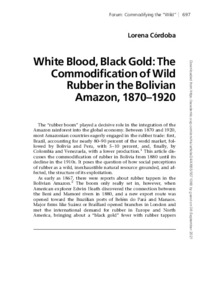Please use this identifier to cite or link to this item:
https://repositorio.uca.edu.ar/handle/123456789/12831| Título: | White blood, black gold : the commodification of wild rubber in the Bolivian Amazon, 1870–1920 | Autor: | Córdoba, Lorena Isabel | Palabras clave: | CAUCHO; AMAZONAS; Bolivia | Fecha de publicación: | 2019 | Editorial: | Oxford University Press | Cita: | Córdoba, L.I. White blood, black gold : the commodification of wild rubber in the Bolivian Amazon, 1870–1920 [en línea]. Environmental History. 2019, 24 doi:10.1093/envhis/emz033-1 Disponible en: https://repositorio.uca.edu.ar/handle/123456789/1283 | Resumen: | Abstract: The “rubber boom” played a decisive role in the integration of the Amazon rainforest into the global economy. Between 1870 and 1920, most Amazonian countries eagerly engaged in the rubber trade: first, Brazil, accounting for nearly 80–90 percent of the world market, followed by Bolivia and Peru, with 5–10 percent, and, finally, by Colombia and Venezuela, with a lower production.1 This article discusses the commodification of rubber in Bolivia from 1880 until its decline in the 1910s. It poses the question of how social perceptions of rubber as a wild, inexhaustible natural resource grounded, and affected, the structure of its exploitation. | URI: | https://repositorio.uca.edu.ar/handle/123456789/12831 | ISSN: | 1084-5453 1930-8892 (online) |
Disciplina: | CIENCIAS SOCIALES | DOI: | 10.1093/envhis/emz033-1 | Derechos: | Acceso abierto | Fuente: | Environmental History. 2019, 24 |
| Appears in Collections: | Artículos |
Files in This Item:
| File | Description | Size | Format | |
|---|---|---|---|---|
| white-blood-black.pdf | 97,08 kB | Adobe PDF |  View/Open |
Page view(s)
87
checked on Apr 27, 2024
Download(s)
149
checked on Apr 27, 2024
Google ScholarTM
Check
Altmetric
Altmetric
This item is licensed under a Creative Commons License

